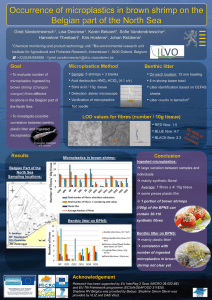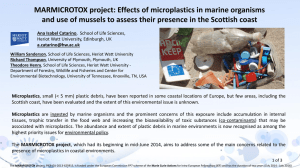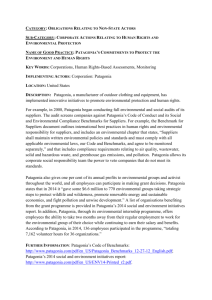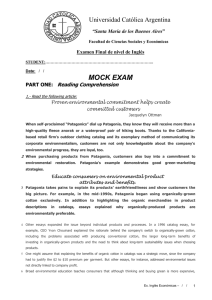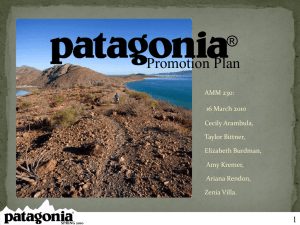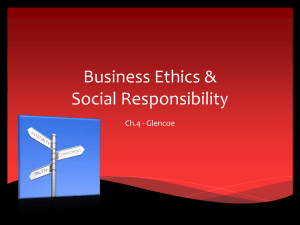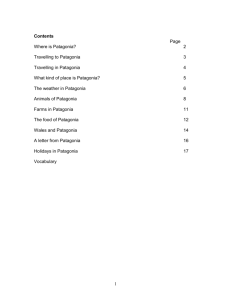Proposal - Bren School of Environmental Science & Management
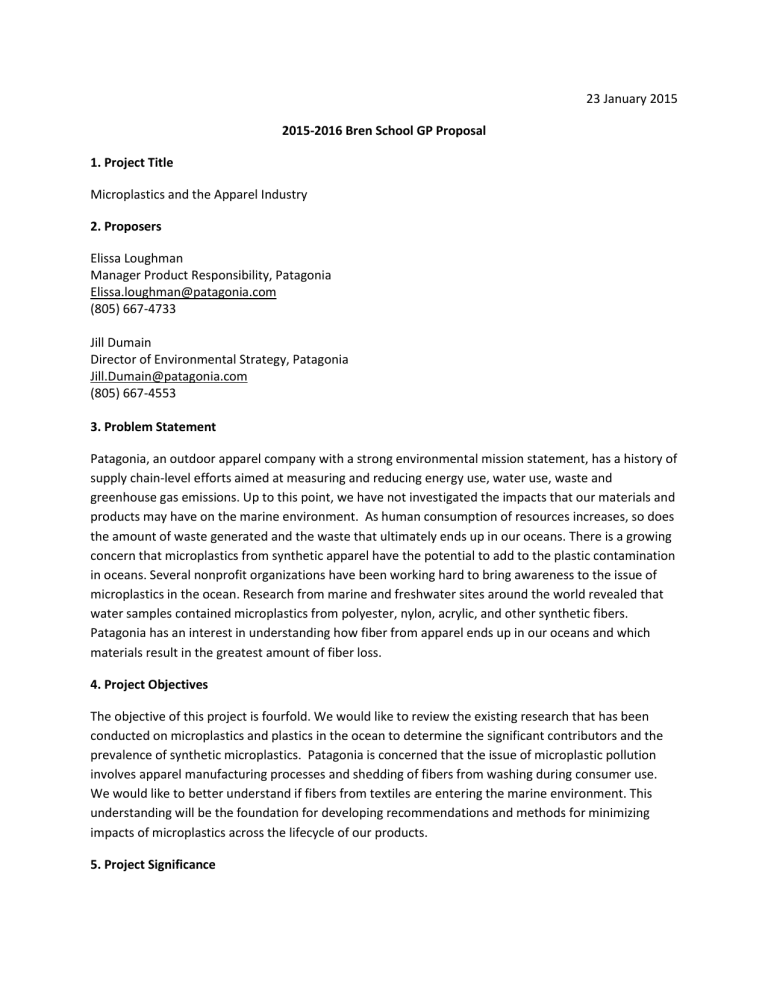
23 January 2015
2015-2016 Bren School GP Proposal
1. Project Title
Microplastics and the Apparel Industry
2. Proposers
Elissa Loughman
Manager Product Responsibility, Patagonia
Elissa.loughman@patagonia.com
(805) 667-4733
Jill Dumain
Director of Environmental Strategy, Patagonia
Jill.Dumain@patagonia.com
(805) 667-4553
3. Problem Statement
Patagonia, an outdoor apparel company with a strong environmental mission statement, has a history of supply chain-level efforts aimed at measuring and reducing energy use, water use, waste and greenhouse gas emissions. Up to this point, we have not investigated the impacts that our materials and products may have on the marine environment. As human consumption of resources increases, so does the amount of waste generated and the waste that ultimately ends up in our oceans. There is a growing concern that microplastics from synthetic apparel have the potential to add to the plastic contamination in oceans. Several nonprofit organizations have been working hard to bring awareness to the issue of microplastics in the ocean. Research from marine and freshwater sites around the world revealed that water samples contained microplastics from polyester, nylon, acrylic, and other synthetic fibers.
Patagonia has an interest in understanding how fiber from apparel ends up in our oceans and which materials result in the greatest amount of fiber loss.
4. Project Objectives
The objective of this project is fourfold. We would like to review the existing research that has been conducted on microplastics and plastics in the ocean to determine the significant contributors and the prevalence of synthetic microplastics. Patagonia is concerned that the issue of microplastic pollution involves apparel manufacturing processes and shedding of fibers from washing during consumer use.
We would like to better understand if fibers from textiles are entering the marine environment. This understanding will be the foundation for developing recommendations and methods for minimizing impacts of microplastics across the lifecycle of our products.
5. Project Significance
Patagonia has often served as a catalyst for environmental change, adopting environmentally friendly strategies such as using organic cotton long before the rest of the industry. By thoroughly evaluating the issue of microplastics in the ocean and the mechanism for how plastics travel to the ocean, this project can help raise awareness about the role that the apparel industry plays in contributing to plastic pollution in the oceans. The results of this project will be used to inform Patagonia about where and what our greatest impacts are regarding microplastics in the ocean. In addition it will provide a context that can be used by other companies to evaluate their own impacts and implement strategies to reduce environmental impacts.
6. Background information
Patagonia has long been dedicated to promoting environmental stewardship both outdoors and within its own facilities. Patagonia’s headquarters are located in Ventura, CA. Patagonia does not own and operate its manufacturing facilities and instead partners with raw material suppliers, fabric vendors and manufacturers. The majority of the supply chain is located abroad, including China, Thailand, Vietnam,
Mexico, and Colombia etc. In addition, our global sales channels enable us to have customers that live throughout world. The nature of our business requires resources and results in waste generation. In addition, Patagonia has a global sales structure and sells products to customers through a global distribution network. As such, Patagonia does not have complete visibility to our global environmental impacts that result from manufacturing products and consumer use of products. It is extremely challenging to know how great our impacts are in all of the regions where we operate.
Patagonia has been taking a detailed look into the impacts of manufacturing clothing, as part of our effort to become a more sustainable business. Key aspects of the product life cycle include raw material origins (farm or wellhead), raw material processing and manufacturing (fiber to textile), product manufacture (sewing and finishing), distribution and sales (wholesale, retail, internet/mail), consumer use and maintenance (laundering), and end-of useful-life (recycle/disposal).
In an effort to understand the impacts our materials and products have on the ocean, Patagonia would like to conduct a research project to determine which materials are being found in the ocean and how significant those impacts are to the larger issue of waste plastic in the ocean. We think this is a great opportunity for a Bren School group project.
7. Stakeholders, other than the client
Apparel Industry - Other companies within the apparel industry and from other industries grappling with the challenge of trying to quantify supply chain and product impacts to ocean environments.
NGOs – The information generated from this project could provide guidance for NGO campaigns highlighting the impacts of microplastics and microplastics to marine environments. Examples of
NGOs involved in marine plastics research advocacy that we have established relationships with include Algalita Marine Research Foundation, Surfrider, the 5 Gyres Institute and the
Adventurers and Scientists for Conservation organization.
Municipal waste water treatment divisions – It will be important to learn about wastewater treatment filters and their potential for capturing microplastics to prevent them from entering the ocean and how municipality practices differ globally.
Academic institutions – Marine research programs such as Scripps may be able to contribute to this project and they may also gain knowledge from their involvement.
Customers – The information gathered through this research can be disseminated to customers to inform them on best practices for washing and caring for their apparel.
8. Possible approaches and available data
Patagonia has the ability to provide lab testing data and fabric specifications that we require from fabric vendors when we source fabrics. Patagonia can provide students with this data or provide students access to the data where needed. Patagonia’s environmental and materials team will provide the industry information and contacts the group will need to gather the necessary data. We haven’t yet gathered data or done testing or research on where/when/how/why fibers shed. The UCSB students will be responsible for that portion of the research. Students will also be expected to gather background research on plastics in the marine environment and global water treatment plant filtering capabilities. In addition to this field research, they will be responsible for gathering data that is not directly related to
Patagonia’s operations via journal articles, internet searches and potentially for communication within the apparel industry.
9. Scope: Microplastic Research Questions/Plan for Understanding and Minimizing Microplastic
Pollution from Apparel
1) Literature Review of marine plastics and microfiber in the ocean a) Microplastics i) Source of microplastics ii) Average size of microplastics iii) Definitions of the various size classifications of marine debris, plastics, fibers
(1) Percentage of each size classification in relation to total marine plastics iv) What are the types of fibers that are found in the marine environment? Which fibers are most abundant and where? v) Impacts of plastics, microplastics, and microfibers on the marine environment and marine organisms vi) What are the various sources of different types of fiber?
2) Review of municipalities – Gathered through literature and interviews and meeting with various municipal treatment plants i) What are the current capabilities of wastewater treatment plants? Limitations, costs, and challenges associated with treatment of microplastics at the municipal level?
(1) How common are the various treatment capabilities? ii) What are the possible solutions at the municipal level? iii) What are the current capabilities on a global scale, particularly in the regions where we manufacture our products?
3) Review of microplastics from consumer use – Gathered through literature and interviews with various industry contacts i) What is the amount of fiber that leaves a home laundering machine in the effluent? ii) What are the best available technologies for filtering microplastics/fibers in washing machines and home laundering? What are the costs and benefits? iii) Research methods used thus far for wash testing in home laundering – clearly explain those methods. Is there a consistent method that is being used? Should there be? If so what is that method?
4) Review of microplastics from manufacturing - literature review and through Patagonia supplier contacts i) Is manufacturing a source of microplastics to the ocean? ii) What are the current technologies in place in Patagonia facilities to capture fibers iii) What are the best available technologies for capturing fiber? What are the costs and benefits? iv) Research methods used thus far for mechanical testing and/or wash testing in fabric manufacturing processes - clearly explain those methods. Is there a consistent method that is being used? Should there be? If so what is that method?
5) Patagonia materials – research conducted with Patagonia materials team and fabric testing lab a) Research existing standards for testing for fiber loss b) Research which materials shed the most fiber and the type of associated fibers c) As a starting point: Non-woven insulation, fleece, anything with a pile would be included and the focus of our interest. Waterproof synthetic woven materials – won’t likely be included
6) Review of the washing machine industry and potential of catching microplastics at this point
10. Deliverables
1.
Literature Review / Background Research of municipalities, consumer use appliances, and manufacturing -> this research will provide a framework for understanding the issues of microfibers relative to the greater issues of plastics/microplastics in the ocean. It will also help
Patagonia to better understand our role in this issue.
2.
Model / Material flow analysis ( to be scoped with the help of Roland Geyer)
3.
Provide a recommended standard method of mechanical testing and/or wash testing in order to determine expected fiber migration from laundering.
4.
Glossary of relevant terminology -> Provide clear definitions in a glossary of terms used in the research of microplastics – ex difference between micro plastics and microfibers
5.
Recommendations for how Patagonia and the textile/apparel industry should address the issue of microplastics in the ocean
11. Client
Patagonia will serve as the client for this project. Patagonia is an outdoor apparel brand with a global supply chain and sales market. The contact person at Patagonia is Elissa Loughman, Manager of Product
Responsibility, elissa.loughman@patagonia.com
12. Anticipated financial needs and additional support
Will provide financial support as needs arise
Provide initial contacts and supporting internal documents
Supervision of the project in collaboration with the Bren students and faculty advisor
13. Internship Opportunities
Paid summer internship for 1 Bren student.
